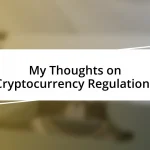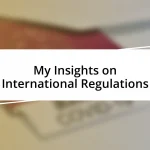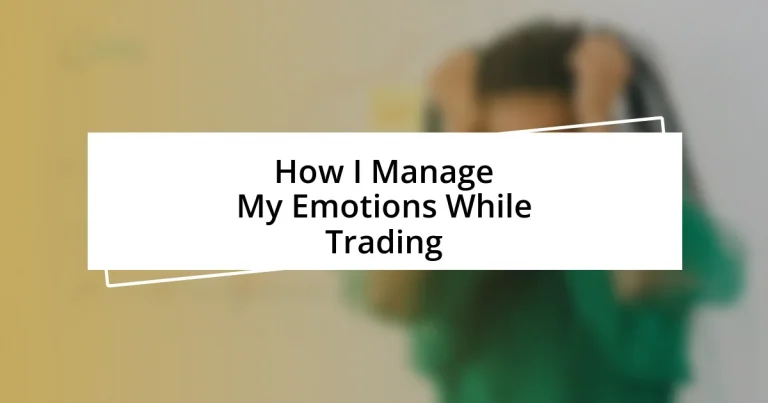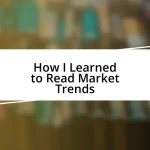Key takeaways:
- Acknowledging and understanding emotional triggers can significantly improve trading decisions and outcomes.
- Implementing structured routines, mindfulness techniques, and keeping a trading journal fosters emotional regulation and discipline in trading.
- Reflecting on emotional growth helps in developing resilience, patience, and a more objective approach to trading challenges.
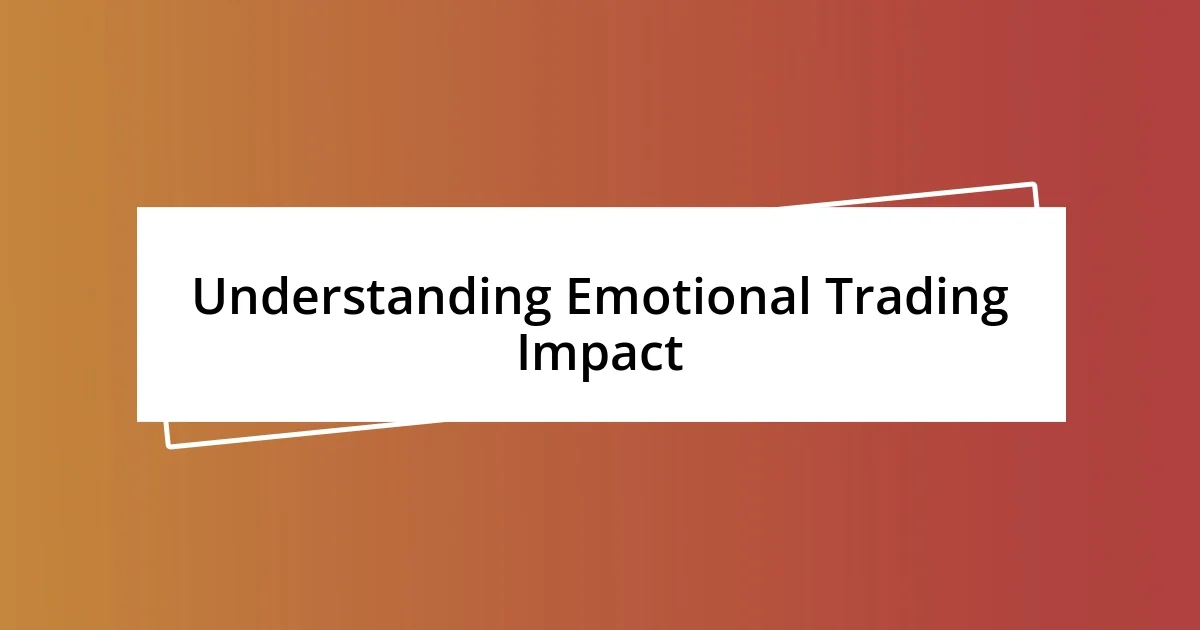
Understanding Emotional Trading Impact
Understanding emotional trading impact is crucial for anyone who has dipped their toes into the financial markets. I remember one time I made a hasty decision to sell a stock simply because I felt anxious about a sudden market dip. That impulsive choice cost me more than just a loss; it taught me how powerful emotions can be in shaping trading decisions.
When I reflect on my trading journey, I often ask myself, “How much of my decision-making is driven by fear or excitement?” This introspection is vital. Emotional trading can cloud judgment, leading to erratic behaviors that contrast starkly with a carefully crafted strategy. It’s easy to get swept away by the highs and lows, but I’ve learned that acknowledging my feelings instead of suppressing them creates a healthier trading mindset.
I’ve noticed that traders often dismiss the importance of emotional awareness, thinking they can separate feelings from decisions. However, when fear creeps in, it can prompt unexpected selling, while overconfidence might lead to reckless investments. What I’ve found helpful is journaling my emotions during trades; it’s enlightening to see how my mood aligns with market movements. This practice not only fosters self-awareness but helps me develop a more disciplined approach.
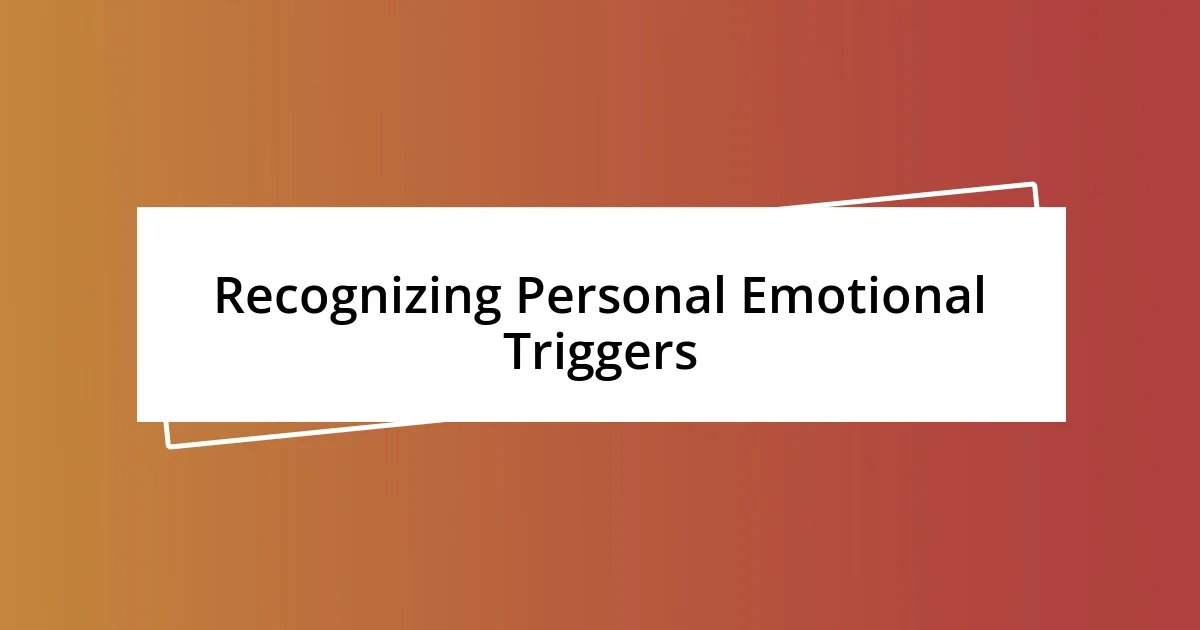
Recognizing Personal Emotional Triggers
Recognizing my emotional triggers while trading has been a game changer. For example, I realized that times of uncertainty in my personal life often amplified my trading anxiety. Whenever I’m dealing with stress elsewhere, I notice that even minor market fluctuations can send me into a panic, leading to impulsive decisions. This insight was crucial; now I take a moment to pause when external stressors are present, ensuring they don’t dictate my trading actions.
To help identify these personal emotional triggers, I recommend considering the following points:
- Reflect on past trades where emotions played a significant role.
- Keep a detailed trading journal that includes emotional states before, during, and after each trade.
- Identify patterns that lead to poor decisions, such as feeling rushed or overly confident.
- Monitor stress levels in other areas of life; they can skew your trading perspective.
- Create a personal checklist of emotions to check in with before executing trades.
Being mindful of these elements has helped me carve out a more objective path in my trading journey.
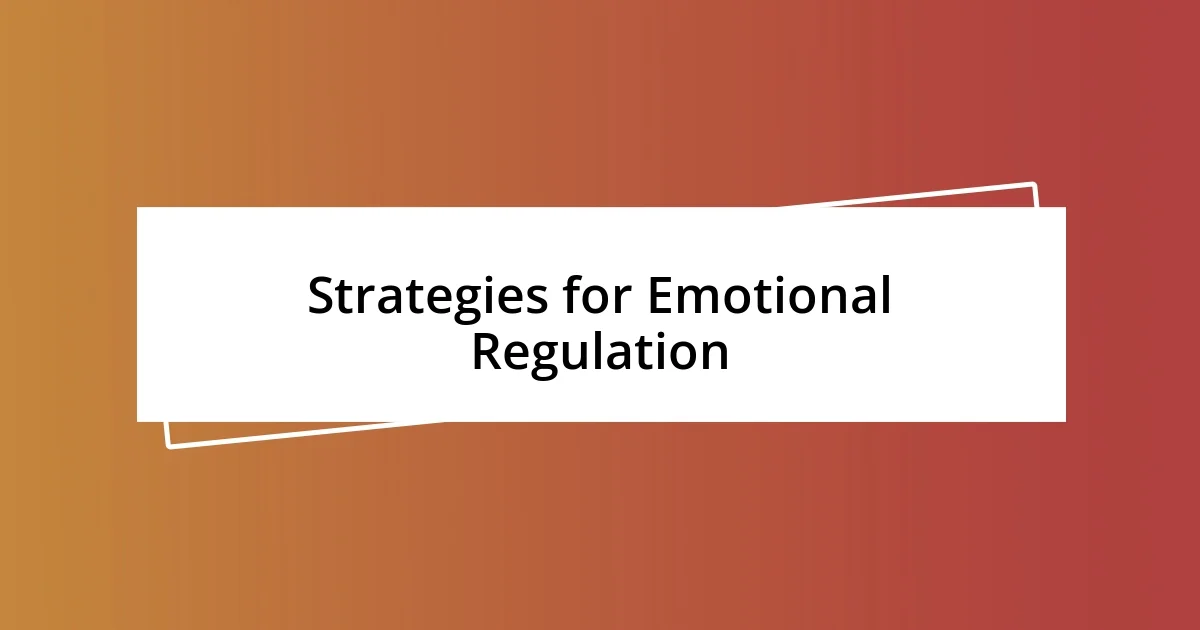
Strategies for Emotional Regulation
Recognizing effective strategies for emotional regulation is essential for consistent trading success. One approach that has worked wonders for me is implementing a structured routine before each trading session. I take the time to meditate for a few minutes, clearing my mind and focusing on my breathing. This practice not only helps ground me but also prepares me mentally to handle the day’s challenges without letting emotions overwhelm my judgment.
Another strategy I’ve adopted is creating specific trading rules based on my personal tolerance for risk and emotional response. For instance, I set predetermined entry and exit points for trades. This strategy reduces the likelihood of impulsive decisions driven by fleeting emotions. In my case, adhering to these rules has transformed my trading process into a more disciplined and systematic approach, ultimately limiting emotional erraticism.
Lastly, I remind myself to take regular breaks during trading sessions. When I’ve felt overwhelmed or emotionally fatigued, stepping away from my screen for a few minutes—sometimes just to stretch or grab a snack—has allowed me to regain clarity. This brief pause helps me recalibrate and return to my decisions with a more objective mindset, ensuring that my actions are aligned with my trading strategy rather than my moments of emotional intensity.
| Strategy | Description |
|---|---|
| Meditation | Clears the mind and prepares for trading, reducing emotional overwhelm. |
| Structured Rules | Establishes clear entry and exit points, minimizing impulsive actions. |
| Regular Breaks | Encourages a moment to pause, recalibrate, and return with clarity. |
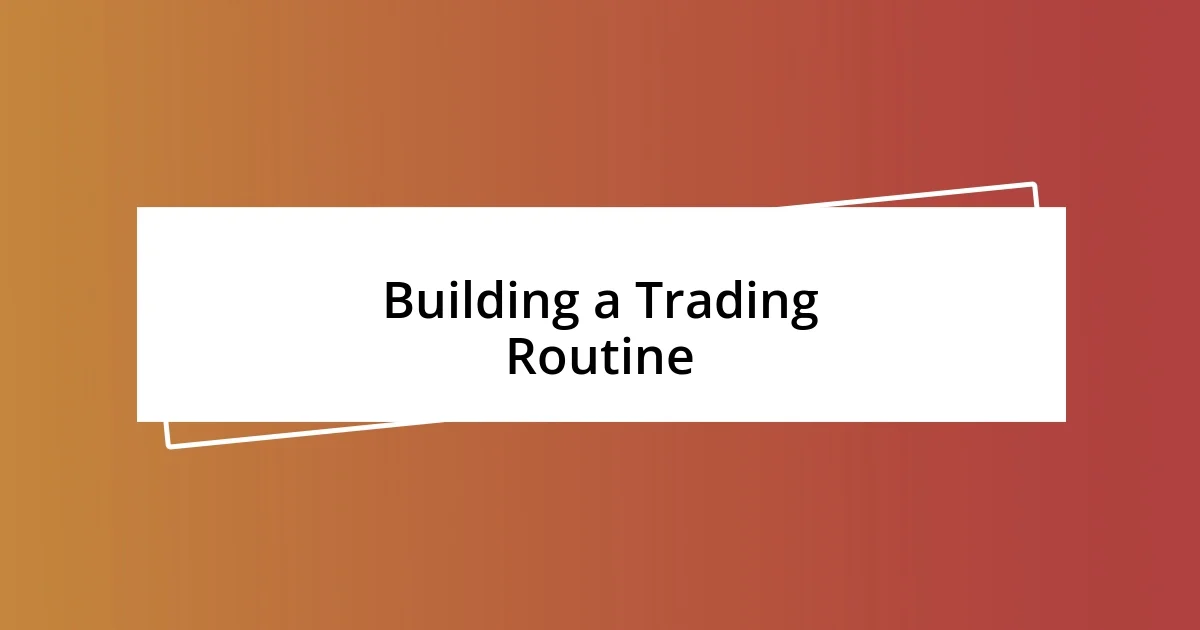
Building a Trading Routine
Building a trading routine has been instrumental in managing my emotions effectively. I remember when I first started trading, I’d jump into the market without any structure, and the results were chaotic. Now, I’ve learned that having a consistent pre-trading ritual, like reviewing my trading strategy and setting intentions for the day, creates a sense of stability. Does this resonate with you? The tranquility that comes from knowing I have a plan helps me approach the market with a clear head.
One key aspect of my routine involves the organization of my trading environment. I like to keep my workspace free of clutter and distractions. I’ve found that simplifying my surroundings helps reduce anxiety and promotes focus. When I walk into my trading area, I want to feel calm and prepared, not overwhelmed by visual noise. Have you ever noticed how your environment affects your mood during trading?
To further reinforce my routine, I also make a habit of debriefing after each trading session. I’ll sit down with my trading journal, reflect on what I did well, and what I could improve. This practice of self-reflection not only aids in emotional processing but also helps me pinpoint areas where my emotions may have clouded my judgment. In my experience, acknowledging my emotional reactions has allowed me to develop a more resilient trading mindset. What strategies do you incorporate in your reflection process?
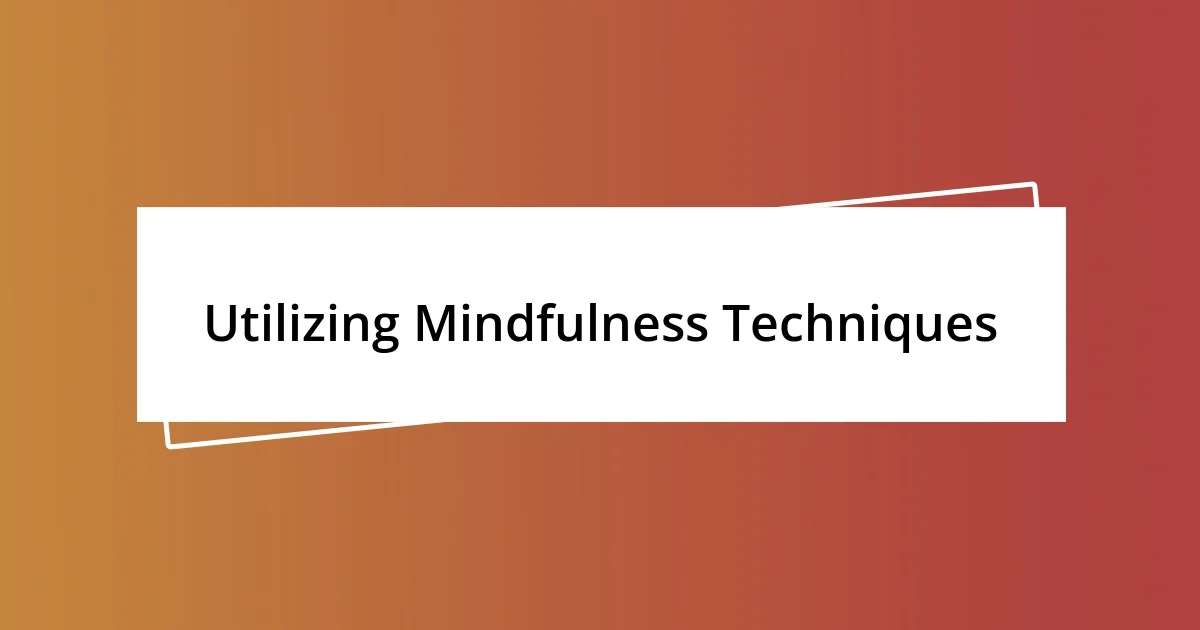
Utilizing Mindfulness Techniques
Mindfulness techniques have been a game-changer for me in navigating the emotional rollercoaster of trading. I’ve embraced practices like deep breathing, which sounds simple, but when I feel my heart racing during volatile market shifts, taking a moment to inhale deeply and exhale slowly brings me back. Have you ever noticed how just a few calming breaths can help reset your mindset? It’s incredible how such a small act can create a significant shift in my emotional state.
Incorporating visualization into my routine has also proven beneficial. I spend a few moments imagining myself successfully executing trades while remaining calm and focused. This mental rehearsal not only prepares me for potential scenarios but also eliminates the anxiety of uncertainty. Honestly, I find that this practice reinforces my confidence. When I visualize success vividly, I feel less overwhelmed when it’s time to put my plan into action. Do you ever use visualization techniques in your own life?
Furthermore, I’ve started to cultivate a habit of practicing gratitude in my trading journal. At the end of each session, I jot down at least three things I appreciate about my trading experience, whether it’s a lesson learned or simply the opportunity to participate in the market. This technique keeps me grounded and shifts my focus away from losses or setbacks. Do you think expressing gratitude in high-pressure situations has the power to change your perspective? For me, it certainly transforms how I approach each trading day.
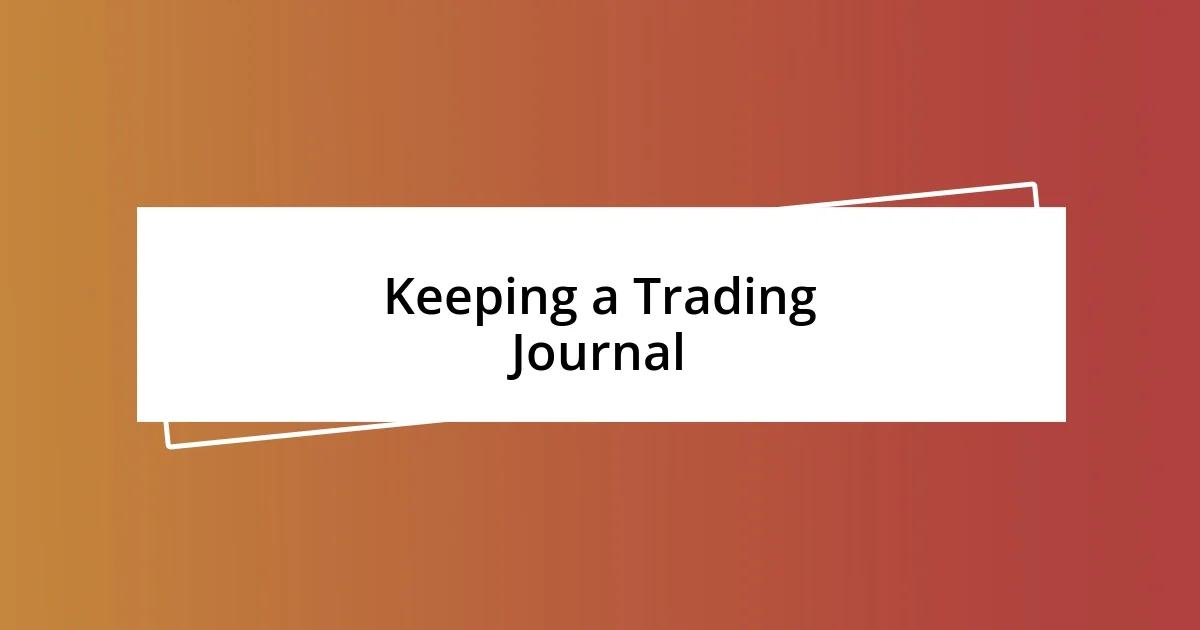
Keeping a Trading Journal
Keeping a trading journal has become one of my most vital tools for managing emotions while trading. Initially, I didn’t see the value in documenting my trades. I thought it was just extra work. But once I committed to this practice, it opened my eyes. Every time I look back on my entries, I can see patterns in my emotional responses to different market situations. Have you ever experienced that “aha” moment when reviewing past trades? It’s enlightening and helps me acknowledge my triggers before they impact my decision-making.
I make it a point to include not only the technical aspects of my trades, like entry and exit points, but also my emotional state at the time. Why do I do this? Because emotions often drive my trading choices, sometimes more than I’d like to admit. For instance, I remember a day when I felt overly confident after a string of wins—I ignored my strategy and made impulsive trades. Reviewing that entry later helped me understand how euphoria can blind my judgment. Have you ever had a similar experience where emotions led you astray?
Moreover, I’ve found it helpful to categorize my trades in my journal. I divide them into sections like “emotional successes” and “emotional pitfalls.” This organization allows me to see not just what I did well, but also when emotions led to poor choices. I often reflect on these emotional pitfalls during quiet moments, considering how I might respond differently in the future. It’s almost like having a personal coach in my pocket! How about you? Do you think categorizing your experiences could unfold valuable insights for your trading journey? In my opinion, this practice not only sharpens my skills but also fortifies my emotional resilience.
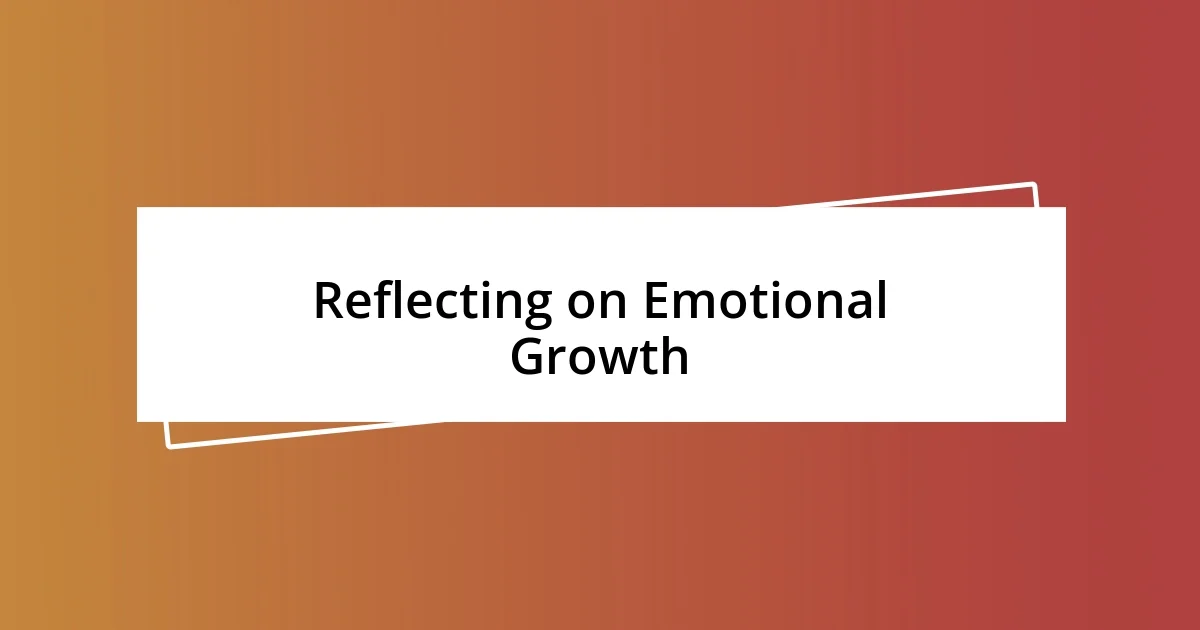
Reflecting on Emotional Growth
Reflecting on my emotional growth has been a profound journey. I can vividly recall when I first started trading; my emotions were often a chaotic mess, with fear and excitement weaving an unpredictable tapestry. Over time, I began to recognize how my emotional responses were closely tied to my performance. Can you recall a time when your emotions dictated your decisions? For me, acknowledging this connection was the first step toward harnessing my feelings rather than letting them control me.
One of the most impactful lessons I’ve learned is the importance of patience. I used to rush into trades, fueled by a blend of anxiety and greed, which often led to regret. Now, I find solace in the stillness before making a decision. I’ve made it a habit to pause, breathe, and assess not only the market conditions but also my emotional state. This pause has taught me that sometimes, the best decision is to wait. Have you ever found yourself in the rush of action, only to realize that stepping back might have been the smarter choice?
Looking back, I often marvel at how far I’ve come emotionally. I now approach trading with a sense of curiosity instead of fear. Recently, I faced a particularly tough day when everything seemed to go wrong. Instead of spiraling into despair, I chose to view it as an opportunity to learn. Was this a turning point for me? Absolutely. Each setback has become a stepping stone, allowing me to adapt and grow emotionally. It’s a process, but one that has made me more resilient in both trading and life. What about you? How do you leverage your emotional experiences to foster growth in your own journey?




